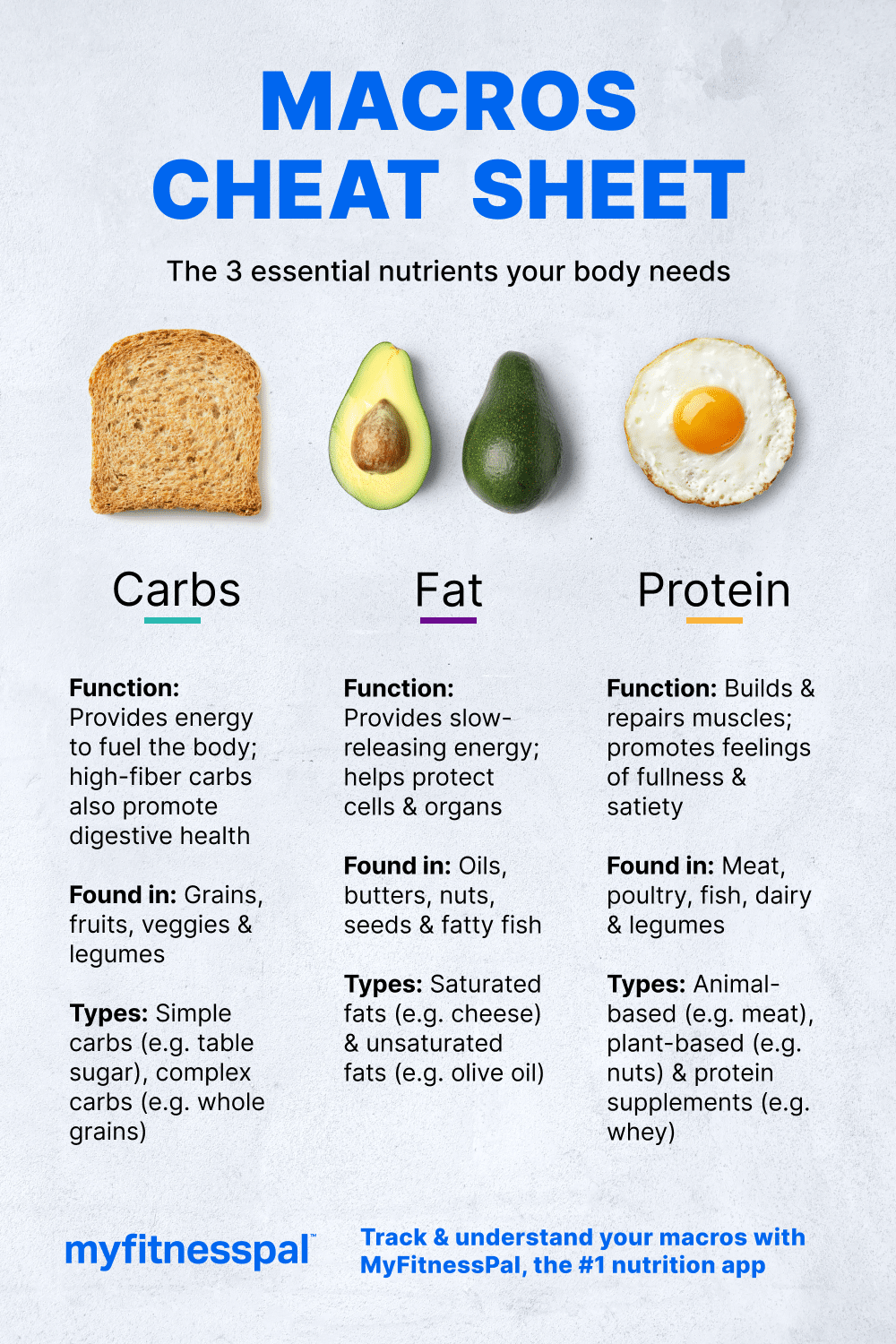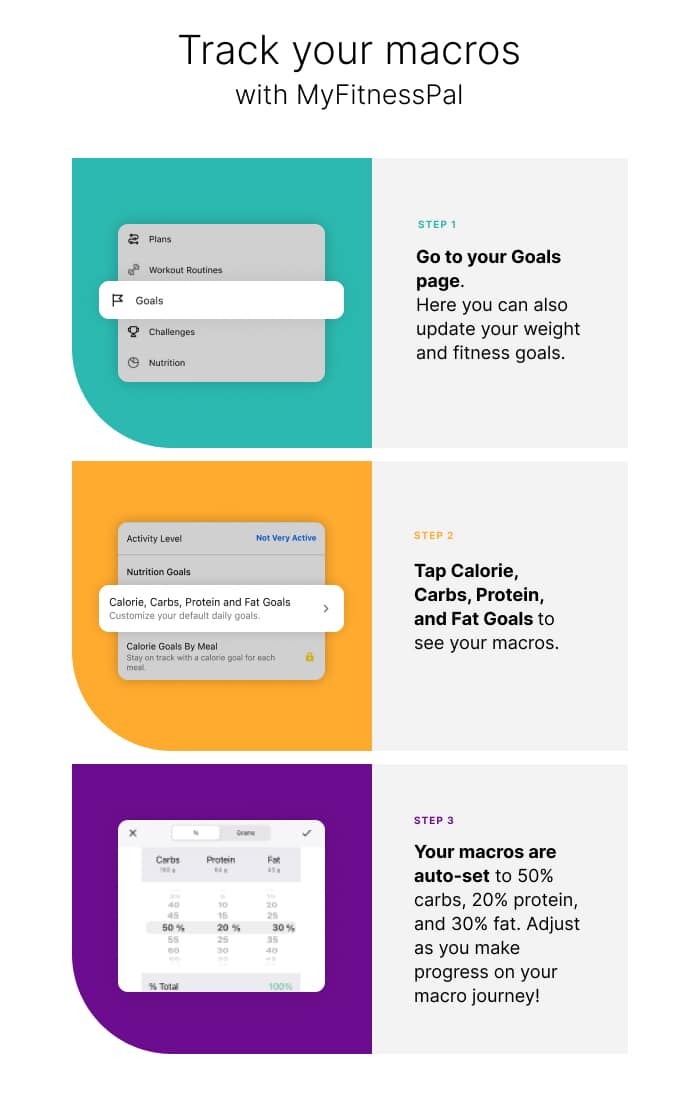If you know a fitness junkie or follow a fitness influencer on social media, you’ve probably heard of the latest weight loss trend: counting macros. A simple search for #countingmacros on Instagram returns more than 355,000 posts with tags like #countingmacroslikeaboss and #macrofriendly.
“Macros” is short for macronutrients, and these essential nutrients keep your body running like a well-oiled machine. Whether you’re trying to lose weight, gain more energy, or simply up your health game, understanding how to consume macronutrients could be your secret weapon.
Let’s take a deep dive into the world of macronutrients, how to count them, and what macro dieting looks like.
What Are Macros in Food?
There are three key types of macronutrients: proteins, carbohydrates, and fats. Each macro is a major source of energy and has a special part to play in helping you become your healthiest self.
Proteins
No, we’re not talking about the powdery supplements that’ll have your biceps bulging out of your dress shirt. We’re talking about the proteins that provide essential amino acids — the building blocks of your body. This macronutrient’s main function is to grow, maintain, and repair your body’s tissues and, yes, muscle mass.
Our bodies need 20 different amino acids, but we can produce only 11 of them. The other nine essential amino acids we need to make proteins in our body come from our food.
So let’s break it down. There are two categories of proteins:
- Complete proteins are typically animal-based and are packed with all nine essential amino acids. To get in your complete proteins, add foods like fish, poultry, beef, dairy, and soy products to your grocery list.
- Incomplete proteins are typically plant-based, yet still beneficial, proteins that contain some of the amino acids. You’ll find these in legumes, nuts, seeds, whole grains, and vegetables.
Carbohydrates
Carbs get a bad rap, but they’re a must-have macronutrient for a balanced diet. If your energy levels are usually on E, carbs may be your saving grace. Our bodies convert these macronutrients — which include fiber, starches, and sugar — into glucose to give us the energy we need to function day in and day out. But not all carbs are created equal.
- Simple carbs: These are sugars that are naturally found in fruit and milk or added to some of our favorite comfort foods like candy, soda, white pasta, and ice cream. They’re also behind the infamous sugar crash, as our bodies break these simple carbs down quickly for energy. Simple carbs are best consumed in moderation.
- Complex carbs: These are the holy grail of carbs. They take longer to digest, which is ideal for managing your weight and some health conditions like diabetes. You’ll find these macronutrients in foods like whole grains, vegetables, and legumes (think: peas and beans). These healthier carbs will give your body what it needs to function at its best.
Fats
This may seem counterproductive, but you also need fats to fuel many major body functions. Unsaturated fats, specifically polyunsaturated fats, contain essential fatty acids omega 3 and omega 6, neither of which are naturally produced in our bodies. And fat helps us store energy to fight illnesses or survive if we go into fasting mode.
But similar to proteins and carbs, some fats are better than others.
There are two types of fat:
- Unsaturated fats are your beneficial fats, helping you improve your blood cholesterol levels and ease inflammation, among other benefits. To pack in these “good” fats, you’ll want to eat more plant foods like nuts, seeds, and vegetable oils.
- Saturated fats aren’t as health-promoting. These fats increase LDL, the bad cholesterol and increase your risk for heart disease and stroke. Try limiting foods like pizza, meat, cookies, and fast food.

How Many Macros Do You Need?
Figuring out your macro requirements isn’t an exact science — it depends on several factors like your age, physical characteristics, activity level, and weight goals. But it’s based on the acceptable macronutrient distribution range (macro percentages) for proteins, carbs, and fats.
Knowing how many macronutrients you need makes it easier to eat the right foods in the right amounts to reach your health goal.
Your ideal macro breakdown should be based on your specific goals and needs, but the following macro ratio is a good starting point:
- 40%–50% of calories from carbohydrates
- 20%–30% of calories from fat
- 30% of calories from protein
How Do You Count Macros?
Now here’s the tricky part — or so it may seem.
Counting macros for beginners may be confusing at first. But calculating how much protein, fat, and carbs you need each day is pretty simple.
The easiest way? Use our Macro Calculator to gain valuable insights personalized to your age, height, weight, sex, activity levels, and goals.
Or, if you’re moderately active, you can go old school and simply multiply your weight by 15 for a ballpark estimate of your recommended calorie intake. Then, plug your macro ratio into a simple formula (see the example below!) to calculate how many grams of protein, fat, and carbs you need each day.
When counting your macros, remember:
- Protein has 4 calories per gram
- Carbohydrate has 4 calories per gram
- Fat has 9 calories per gram
Example
Say you want to eat a 2,000-calorie diet. Use the 40:30:30 macro ratio to figure out your calorie split across carbs (40%), protein (30%), and fat (30%):
- 30% of 2,000 calories (2,000 x 0.3) = 600 calories from protein each day
- 600 calories of protein divided by 4 calories per gram (600/4) = 150 grams of protein per day
Pretty easy, right? You’ll use the same formula to calculate your fat and carbohydrate intake.
Don’t forget: if you want to make “math-ing” a little easier, use our Macro Calculator!
Once you have your numbers, start tracking your macros via a website, app, or food journal. MyFitnessPal is the best macro-tracking app for monitoring your daily macro percentages (with a useful pie chart so you can quickly scan your daily progress).
What Is a Macro Diet? (+Examples!)
If fad diets are your thing, then you’ll be happy to know there are a few popular diets that emphasize macro foods. Here are some examples of macro diets, how they work, and the foods you should eat on each one.
Note: These diets typically work via caloric deficit which ultimately leads to weight loss, but ultimately are very restrictive and difficult to sustain long term. Nothing compares to a diet inclusive of all major food groups, that is adjusted to create a caloric deficit, alongside exercise. Consult with your physician before starting any new diet regime.
Paleo diet overview and foods
The Paleo diet, also known as the caveman or Stone Age diet, features foods we assume were eaten by humans during the Paleolithic era. In other words, foods that can only be hunted or gathered.
You can bid adieu to high-fat and processed foods on this diet and focus your gaze on lean meats, fruits, and vegetables. Pro-Paleo dieters claim it helps reduce inflammation, strengthen immune function, and fight disease.
The Paleo diet recommends a macro ratio of 30% protein, 40% fat, and 30% carbs. Here’s a list of macro foods to stock up on:
- Meat
- Fish and seafood
- Eggs
- Fruits and vegetables
- Nuts and seeds
- Healthy fats and oils
- Salt and spices
Keto diet overview and food sources
Unless you live under a rock, you’ve likely heard about the ketogenic diet.
Unlike most diets, keto encourages fat — and lots of it — to provide your body with an alternative source of energy. Instead of relying on energy supplied by carbs, it uses ketone bodies, a more technically efficient energy source provided by fat, to fuel your brain, heart, muscles, and other vital organs.
The typical keto diet is about 70%–80% fat, 10%–20% protein, and 5%–10% carbs. The foods you can eat on a keto diet include:
- Fish and seafood
- Meat and poultry
- Non-starchy vegetables
- Avocados
- Berries
- Nuts and seeds
- Eggs
- High-fat dairy products
- Olive oil and other oils
- Chocolate with a high cacao content
If It Fits Your Macros (IIFYM) diet overview
For those of us who prefer to eat your cake AND lose weight, this flexible macros diet plan is probably the best option. IIFYM focuses on counting macronutrients without restricting the foods you eat.
Basically, this diet allows for some flexibility. You may be able to still have the foods you desire that may not be so healthy, in moderation, and still lose weight.
If healthy eating is on your agenda, this diet probably isn’t for you.
Fill Your Body With Energy Through a Healthy Diet
Macronutrients are the body’s main energy source and power critical functions. Getting the right amount of these nutrients can help you reach your health and weight goals.
Macros may require a little more effort than simply counting calories, but it’s well worth the results you’ll see in the long run.
Ready to start tracking your macros? Download the MyFitnessPal app (for free!)

Originally published June 08, 2022. Updated March 1, 2024.





